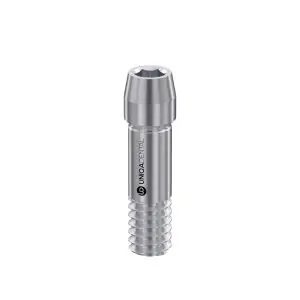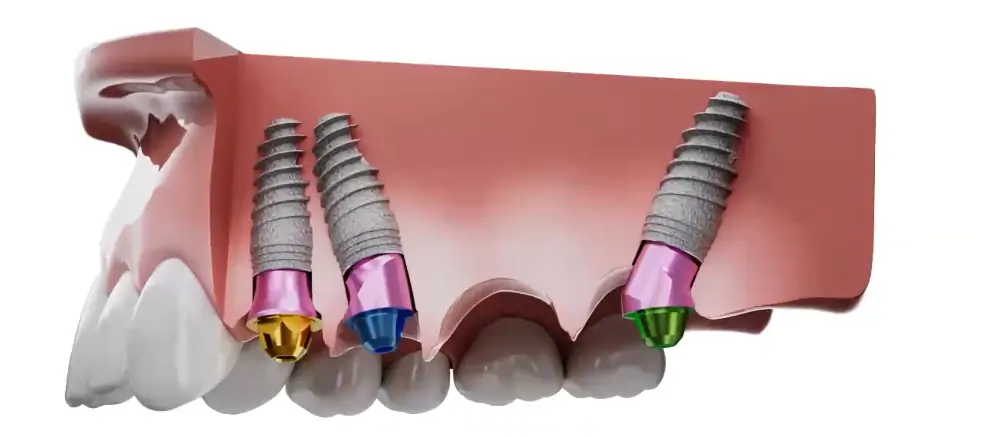Adin® Compatible Angled Abutments
Showing all 4 results
Related products
Adin® Angled Abutments – Optimal Dental Implant Solutions
Welcome to the specialized category of Adin® Angled Abutments, exclusively presented by Uniqa Dental. As your trusted partner in e-commerce, we offer premium-grade abutments that are compatible with Adin® implants. These are precision-engineered to mirror the original abutments, ensuring the same angles, shoulder options, and platform benefits. Crafted using medical-grade titanium alloy, our products guarantee flawless integration with AB Dental implants.
Why Choose Adin® Compatible Solutions?
Adin® Angled Abutments are renowned for their cutting-edge design and unmatched material quality. These angled abutments can be bought in distinct angles of 15° and 25°, and they come equipped with both non-shouldered and shouldered options. This vast array of choices empowers dental professionals to shop for the perfect fit, tailored to the unique requirements of each patient.
These abutments feature an Internal Hex 3.5 RP platform/connection, ensuring a steadfast and consistent connection to the implant. This crucial attribute promises unparalleled stability, extending the longevity of dental restorations. With gingival heights available in H9 and H12 sizes, Adin® Angled Abutments cater to a wide range of clinical scenarios, providing diverse possibilities for implant restorations.
We prioritize quality. Our abutments are meticulously crafted using Grade 23 medical titanium alloy, which closely rivals the strength of the popular Grade 5 but excels in plasticity. This makes it ideal for producing thin components. For restoration, we employ the cement restoration method, a proven technique that ensures reliability and compensates for minor variations in prosthesis crafting. The recommended torque value for these abutments is set at 30 Ncm, ensuring a secure and sturdy placement within the implant.
Adin® Compatible Components
Browse our range of components, all seamlessly compatible with the Adin® platform:
- Adin® Compatible Straight Abutments – Shop for the right diameters, connection types, and heights tailored for your Adin® implant.
- Adin® Compatible Abutment Screws – Securely fix abutments to Adin® implants, ensuring longevity and stability.
- Adin® Compatible Healing Caps – Protect Adin® implants during the crucial osseointegration phase.
With our comprehensive set of specialized components, dental professionals can effortlessly assemble a complete set for dental row restoration, ensuring 100% compatibility with Adin® implants.
Adin® Angled Abutment Specifications
| Platform | Angle | Gingival Height | Anatomic Ledge | Material | Restoration | Torque | Precision |
| Internal Hex 3.5 RP | 15° | H9 mm, H12 mm | Non-shouldered | Grade 23 medical titanium alloy | Cement restoration | 30 Ncm | 0.02 mm |
| Internal Hex 3.5 RP | 15° | H9 mm, H12 mm | Shouldered | Grade 23 medical titanium alloy | Cement restoration | 30 Ncm | 0.02 mm |
| Internal Hex 3.5 RP | 25° | H9 mm, H12 mm | Non-shouldered | Grade 23 medical titanium alloy | Cement restoration | 30 Ncm | 0.02 mm |
| Internal Hex 3.5 RP | 25° | H9 mm, H12 mm | Shouldered | Grade 23 medical titanium alloy | Cement restoration | 30 Ncm | 0.02 mm |
Experience Quality, Certification, and Exceptional Customer Service with Uniqa Dental
When you shop at Uniqa Dental, you’re investing in more than just premium products. Every item, including our Adin® Angled Abutments, adheres to the highest quality standards, backed by our FDA K180598, ISO 13485, CE 0483, AMAR 30810002 certifications, and more. Explore our complete list of certifications on our quality assurance page.
We understand the importance of timely delivery. That’s why we provide free global shipping, ensuring your order is with you within 1–2 business days. Our payment gateways are fortified with SSL certification, and we accept payments through Credit Cards, PayPal, Google Pay, and Apple Pay, offering a safe and streamlined transaction process. Plus, our return policy is customer-friendly, allowing returns within 60 days of receipt.
Our commitment to you doesn’t end with a sale. At Uniqa Dental, our expert support team is always on hand to assist with any queries and to help process your order efficiently. For personalized support, connect with us through our Uniqa Personal Manager portal.
Choose Uniqa Dental for Adin® Angled Abutments and experience unmatched precision, quality, and service for all your dental implant needs.
Buy Angled Abutments Compatible with Most Implant Platforms
The process of choosing an abutment is just as important as choosing the implant itself and is inextricably linked to the clinical picture of the patient. Quite often it makes sense to place the implants at different angles relative to the future dental restoration. This allows for much better primary stability. And later on, a system with differently angled implants shows better load distribution and reduces the risk of implant loss. Angled abutments are needed to compensate for the tilt and alignment of the dentition. It is recommended to choose angled abutments in close cooperation with a dental technician based on a 3D computer model or impression. This is the only way to achieve a dental restoration without overstressing and risking the breakage of the crown or abutment.
The illustration below shows just such a case, where one abutment is straight and two are angled at different angles. This allows the final restoration to be fabricated and a bridge with good dissipation of the physiological stresses during mastication.

























